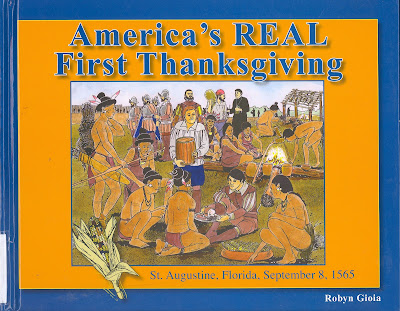Monday Morning Book Review: America's REAL First Thanksgiving
One of my favorite times to live in St. Augustine is Thanksgiving. The weather is perfect, the city floods with visitors interested in history, and we get all up in people's faces about America's REAL Thanksgiving. The Mayor puts out an APB with excerpts from Dr. Michael Gannon's Cross in the Sand (1965), after which he earned the title: The Grinch Who Stole Thanksgiving." Robyn Gioia found inspiration in Gannon's story and translated the spirit of his words into her book, America's REAL First Thanksgiving: St. Augustine, Florida, September 8, 1565 (2007 Pineapple Press, Sarasota). Our Center has a copy and I myself find it a useful resource--more than just for New England taunting!
 |
| Sample page 7, map from Plantin Polyglot Bible 1569-1572. |
For one, Robyn has done a wonderful job of setting the stage for Spanish settlement of La Florida. The book begins with chapters on the world of 1565, both Spain and Florida in the 1560s. The weight of the Spanish is balanced with a chapter on the Timucua, the first Native Americans to encounter the Spanish during Ponce de Leon's 1513 visit and the first group Pedro Menendez encountered when he founded St. Augustine in 1565. Timucuan tools and ornaments recovered from archaeological investigations are featured graphics throughout the book. I appreciate the emphasis on Florida's environment, a major factor for both cultures.
Besides a historical narrative, the books offers different ways to digest the significance of the Timucuan and Spanish encounter--literally! A timeline and glossary are included at the back as an aid to readers. There are some really great references listed at the back an a long author's note citing Gannon in his own words. The book also has a recipe for Cocido, a garbanzo bean soup that has become the hallmark of dish of St. Augustine's Thanksgiving. The recipe includes a mix of Native and Spanish ingredients: garbanzo beans, chorizo, salt poke, savoy cabbage, leeks, onion, carrots, pepper and saffron. And don't forget the garlic! Robyn refers readers to other historic Spanish recipes in Maggi Smith Hall's book Flavors of St. Augustine: An Historic Cookbook.
Did I mention the book is fun? A combination of primary and secondary sources are used to graphically support the text, as well as original artwork by the author, Robert Deaton, Theodore Morris, and David Meek to mention a few. There are lots of facts and historically researched data, but there are also several interpretive moments that I've used in the past to bring students closer to the past:
 If we close our eyes, we can imagine the smell of a roaring fire. We can envision the Timucua savoring their first taste of onion and herbs in cocido, as well as the flavor of salted pork cooked into the stew. The Spaniards may be experiencing their first taste of alligator or bread made with corn. We can smell the fruity aroma of red wine in the cups and imagine the careful passing of food platters. While listening to the sounds of the day, we can hear the rapid beat of the Spanish tongue and the now-extinct language of the Timucua. And at dusk, we feel a gentle breeze roll in from the ocean...
If we close our eyes, we can imagine the smell of a roaring fire. We can envision the Timucua savoring their first taste of onion and herbs in cocido, as well as the flavor of salted pork cooked into the stew. The Spaniards may be experiencing their first taste of alligator or bread made with corn. We can smell the fruity aroma of red wine in the cups and imagine the careful passing of food platters. While listening to the sounds of the day, we can hear the rapid beat of the Spanish tongue and the now-extinct language of the Timucua. And at dusk, we feel a gentle breeze roll in from the ocean...And the passage goes on to connect the five-sense experience the group may have experienced in 1565 (Gioia 2007, p. 38 and illustration p. 39 by Robert Deaton).
 |
| Robyn getting hands on at lithic workshop. |
My only word of caution is the use of the 16th century Le Moyne drawings. The drawings are a great resource, but you have to use them with caution. We now know Le Moyne re-used drawing composition and themes regardless of geographic location. Keith Ashley in a talk last year made the comparison to clip art...women arranged in the same seated positions for South American tribes are repeated for the Florida drawings. In addition, some features are exaggerated or lack common sense. You might want to check out the Pelotes Preserve's website to help you navigate through some of these issues, Le Moyne Drawings. A potentially great teachable moment awaits you by deliberating with your kids or students over the likelihood of historical accuracy for the drawings.
For more information check out the Robyn Gioia official website, or this 2007 USA Today article:
Florida teacher chips away at Plymouth Rock Thanksgiving myth.
The book can be purchased in local book store or on-line at Barnes&Noble or Amazon. I just noticed when I looked up the ordering information that there is a teacher's manual available for the book...will check it out an report back!

